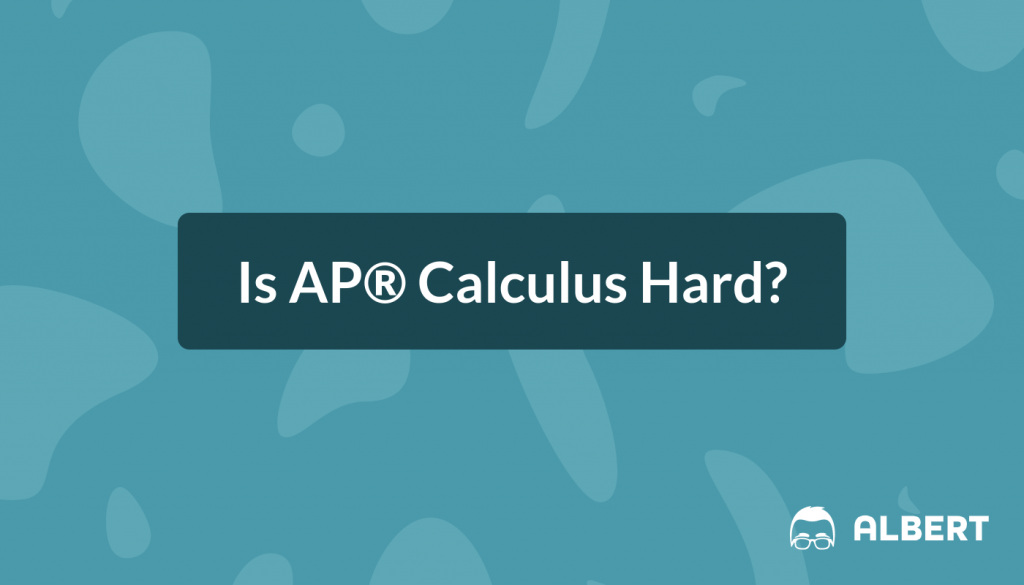Math as a whole can strike literal fear and panic into the hearts of many students. Higher level math like calculus offers many benefits, but the anxiety surrounding complex math problems repel many from even trying to learn. If you’re asking “Is AP® Calculus Hard?”, there’s at least a little worry about tackling this course. We’ve already taken the first step in dealing with fear by acknowledging it. We can’t guarantee that AP® Physics will feel less concerning by the end of this article, but we can explain what makes AP® Calculus hard and what step you can take to be successful.
AP® Calculus AB
| 2011 | 2012 | 2013 | 2014 | 2015 | 2016 | |
| 5 | 21.4% | 25.2% | 23.9% | 24.6% | 21.8% | 24.8% |
| 4 | 16.4% | 17.1% | 18.1% | 16.6% | 17.0% | 17.3% |
| 3 | 18.5% | 17.4% | 17.3% | 17.7% | 18.6% | 17.4% |
| 2 | 10.7% | 10.2% | 11.2% | 10.7% | 10.3% | 9.7% |
| 1 | 33.1% | 30.2% | 29.4% | 30.5% | 32.3% | 30.7% |
AP® Calculus BC
| 2011 | 2012 | 2013 | 2014 | 2015 | 2016 | |
| 5 | 47.6% | 50.4% | 45.8% | 48.4% | 45.4% | 48.5% |
| 4 | 15.9% | 16.1% | 16.1% | 16.5% | 16.4% | 15.4% |
| 3 | 16.7% | 15.8% | 17.9% | 16.2% | 18.0% | 17.2% |
| 2 | 5.9% | 5.4% | 5.7% | 5.3% | 5.5% | 5.8% |
| 1 | 13.9% | 12.3% | 14.4% | 13.6% | 14.8% | 13.2% |
AP® Calculus BC Sub-score
| 2011 | 2012 | 2013 | 2014 | 2015 | 2016 | |
| 5 | 55.1% | 59.2% | 56.0% | 55.1% | 56.1% | 51.1% |
| 4 | 17.9% | 16.9% | 19.9% | 16.6% | 16.3% | 20.9% |
| 3 | 13.2% | 9.8% | 11.3% | 12.9% | 12.8% | 13.1% |
| 2 | 4.9% | 5.8% | 5.4% | 6.4% | 5.5% | 4.6% |
| 1 | 8.9% | 8.3% | 7.4% | 9.0% | 9.4% | 10.3% |
By the Numbers
There’s a lot to consider when looking at the numbers for AP® Calculus AB or BC. First, notice that the scores are VERY different for the two calculus courses. Based on the numbers alone, it might appear that AP® Calculus BC is easier than AP® Calculus AB, but this is a bit misleading. Calculus BC contains all of Calculus AB’s information, plus extra sections on series and sequences. In fact, many of the Calculus AB questions will also appear on the Calculus BC exam. So why are the scores higher for Calc BC if the class is harder? It comes down to experience and self-selection. Most students that take Calculus BC instead of AB are very confident in their math abilities. If that confidence is based on any truth, it is expected that the BC crowd are more prepared for Calculus and will consequently do better. The other factor is experience. Some students only take BC after they have more experience, such as first taking high school calculus or Calculus AB.
The score distributions are somewhat odd for both Calculus classes. One expects one score to be most probable, and then scores get progressively less occupied as the scores move away from the most common value. For AP® Calculus AB, the most common AP® score is a 1, and the second most common score is a 5! This could signify that there are two groups of students who take AP® Calculus AB: the ones who “got” it and the ones who did not. The students that got it tend to do very well (40% 4+ scores are uncommon in APs) and the ones who didn’t have incredible struggles on the exam.
The scores for Calculus BC, on the other hand, are among the highest of any AP® class. Close to half of test takers make 5s on the BC exam, and the scores are even higher if you only focus on the Calculus AB questions within the Calculus BC exam (given by the sub-score).
It certainly seems that AP® Calculus works well for some students, and not as well for others. In the next few sections, let’s see if we can figure out what is so hard about AP® Calculus
Exam Structure
Both AP® Calculus exams have the same structure. They each have a multiple choice section and free response sections that are each divided into one part with a calculator and one part without a calculator. The total time for these exams is 3 hours and 15 minutes
Section: I –Multiple Choice

Part A—28 questions, 55 minutes, No calculator
The questions in this section put a slight emphasis on proper process and methodology, over solving numerically complex answers. The answers will not require much arithmetic, and most answers will be relatively simple numbers (integers, simple fractions) and functions. This section focuses on knowing the proper steps, terminology, definitions and concepts. While the numbers are easier than in other parts of the exam, this section may be more abstract, which is a challenge for many students
Part B—17 questions, 50 minutes, calculator
The numbers will not be so neat in this section. The goal here is to apply calculus concepts to very exact math problems. This will often yield irrational numbers (non-terminating, non-repeating decimals, though usually rounded to three decimal places) While the calculations will be more difficult from an arithmetic standpoint, you may find it easier when you can plug exact numbers into formulas to confirm your answer. You will still need to understand the appropriate steps because many of these problems will be too involved to guess and check in the time allotted.
Section: 2—Free Response
Part A—2 questions, 30 minutes, calculator
Like the calculator section of the multiple-choice, this section will have numerically complex calculations where you will frequently need a graphing calculator. Don’t expect to just “plug and chug” in this section. There will be a lot of computation, but you will not be able to fake an understanding of calculus with any calculator tricks. If you do not finish this section in the allotted 30 minutes, you can continue to work on the problem during the time for the next section. You will have to do so without a calculator, however, so budget your time appropriately to get the best use of your calculator
Part B—4 questions, 60 minutes, no calculator
This section has less numerical calculations but a greater emphasis on understanding definitions, theorems, and estimation strategies. These aspects of math often get lost with a focus on getting to exact numbers, but is very apparent in this section of the exam. You may also need to explain aspects of your answer with words, so you will have to practice translating numerical and quantitative information into words.
Content

AP® Calculus is divided into a set of “Big Ideas” which outline the significant aspects of the course. The first three Big Ideas are used for both Calculus AB and Calculus BC, but Calculus BC includes a fourth Big Idea as well.
Big Idea 1: Limits
Limits are perhaps the most fundamental element of calculus. Limits allow us to use patterns and trends in functions to extrapolate a great deal of extra information; even about points that we cannot calculate directly. Limits are often underappreciated and forgotten as new and more immediately useful concepts are learned. The AP® Calculus exam places particular emphasis on limits, so you will have to keep this Big Idea fresh in your mind.
Big Idea 2: Derivatives
Derivatives help us understand how one variable changes with respect to another in a function. You’ve already studied mathematical change in the form of slopes, but derivatives expand on these concepts and allow you to define the rate of change for curves in addition to lines. Derivatives have a lot of applications in both pure math and real-world situations, so you will spend a lot of time learning how to find the derivatives of various functions.
Big Idea 3: Integrals and the Fundamental Theorem of Calculus
In some respects, integrals can be thought of as the opposite of derivatives. Whereas derivatives help us describe a function regarding infinitely small (infinitesimal) changes, integrals let us combine infinitesimal information into new functions that can give us a lot of information. Have you ever wondered how people discovered the equations for areas and volumes of shapes? They were derived using ideas that would later be developed into integration. Most students begin their studies on integrals as the area under a curve, but you will learn that integration has far more to offer.
Big Idea 4: Series
This topic will only be covered in the Calculus BC course. A series is a sum of numbers. Even though you have been adding and subtracting for years, now you will see a new side to these old operations in Calculus. Did you know that you can add an infinite number of positive, non-zero numbers and get an exact answer? While this may seem like an impossible idea, calculus has ways to make it happen. Students learning this Big Idea will study some different series and figure out how to evaluate them. This section is of great importance for estimating a number of mathematical constants and formulas. Ever wonder how people quantified numbers like pi and square roots to such high precision? In this section you will learn the techniques that yield these answers.
Skills Required

As we’ve discussed, AP® Calculus is hard. Thankfully, this does not mean that learning a lot and making high scores is beyond your reach. Let’s go over some key requirements that contribute to the difficulty of these courses
Solid math background. The CollegeBoard recommends at least four years of high school math before you attempt AP® Calculus. You need to have a strong grasp of algebra, geometry, trigonometry, analytical geometry. You will also need to be comfortable working with polynomials, exponential functions, piece-wise defined functions and several others. In many schools, these concepts are covered in classes named Algebra I, Algebra II, Geometry, Trigonometry, and Pre-Calculus. There may be a part of you that wants to skip some of these courses and just take AP® Calc. That part of you is very, very wrong. There is a lot of information and skills to master in AP® Calculus, and you will not be able to do so reliably without a strong foundation in mathematics.
Notational literacy. There are a number of new symbols and writing conventions that are frequently used in calculus. These symbols will summarize a lot of information, and it is easy to forget parts or implications of their meaning. These symbols will be used during lessons and in problems, so they eventually become as important as words for communication. You will have to develop what the CollegeBoard calls “notational fluency” to keep up with learning new material and figuring out what questions are asking for
Symbolic math. You will be moving around a lot of numbers and variables without necessarily doing arithmetic or calculating specific numbers. This can get very abstract, which is usually more confusing than working with exact values. One of the best ways to master this element of the course is to maintain conscience focus on algebra throughout AP® Calculus. You already know algebra, but your skills probably aren’t perfect yet. If you find yourself distributing terms incorrectly or messing up the order of operations, take a study session to clear up and hone any rusty math skills.
Reading skills. Calculus will have a lot more words than you typically see in high school math classes. You will be learning many general concepts and procedures that cannot be adequately described using calculations alone. You will need to be familiar with some theorems and proofs, and be able to apply them to mathematical problems. Calculus also requires very close attention to word choice to avoid miscommunication. You’ve had some exposure such skills through geometric proofs, and AP® Calculus will require you to use these skills in new ways.
Is AP® Calculus Worth it?
Either AP® Calculus class will be tough and require a lot of time and effort, but learning calculus can open a lot of doors. Almost every major in math (including statistics), science, engineering, computer science, finance, and economics will have to take some form of calculus. Earning college credit from AP® Calculus will save you time and money, and open opportunities in classes for which calculus is a prerequisite. Even if math is not part of your college major, you will likely have general education requirements in math that can be satisfied by AP® Calculus. And if you don’t get college credit, AP® Calculus will still give you earlier exposure to college level math. Calculus is very different from earlier math courses, so many students just need time to wrap their heads around the content. An extra calculus class in high school may give you the time you need to make a strong start in your college math career.
Next Steps for AP® Calculus
If you think AP® Calculus is for you, the first step is to figure out which course to take (assuming your school has access to both). Don’t let the scores trick you. AP® Calculus BC covers more material over in the same amount of time as AP® Calculus, so it will go at a faster pace and therefore be more difficult. Ask the AP® teachers, guidance counselors, and former students to get a better idea of the courses at your school. Be sure to ask about any addition requirements that your school or AP® teacher may have.
Once that is out of the way, start looking into study aides to help you. There are many review books, practice problems and study guides that can make your learning much smoother. AP® Calculus AB and BC are both hard, but with the right attitude and resources, you can still best these courses.
Looking for AP® Calculus practice?
Kickstart your AP® Calculus prep with Albert. Start your AP® exam prep today.








